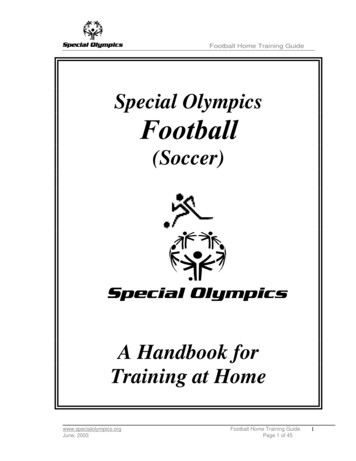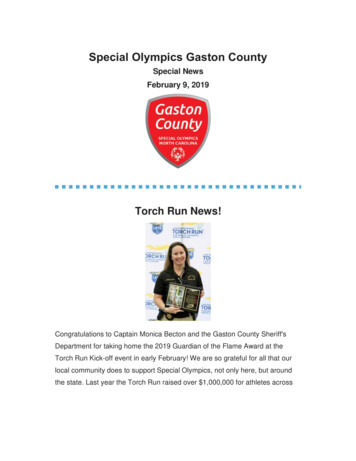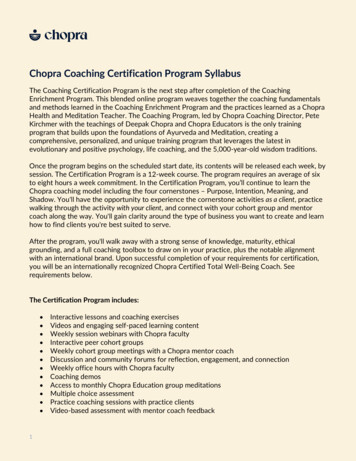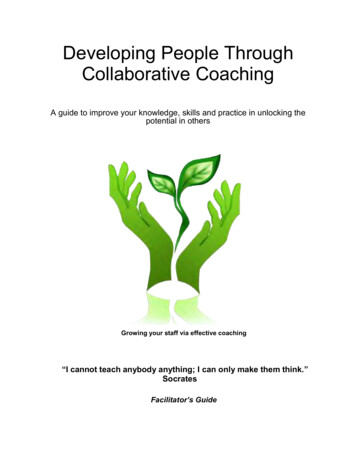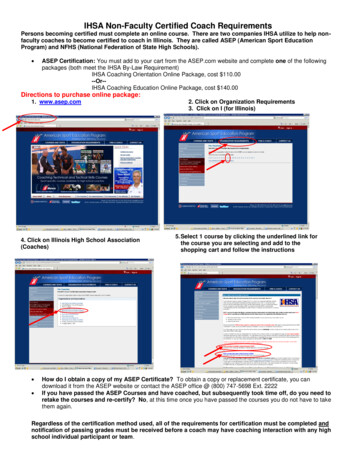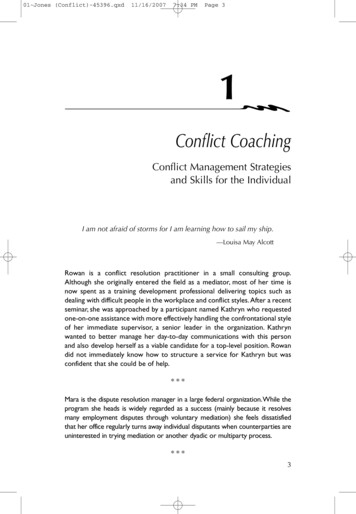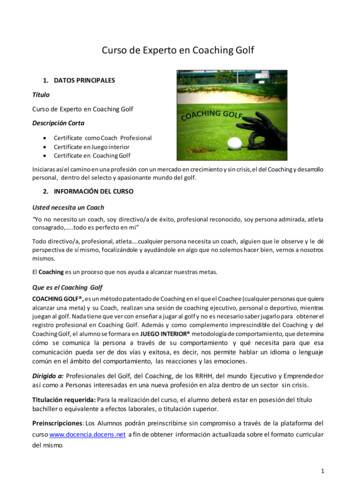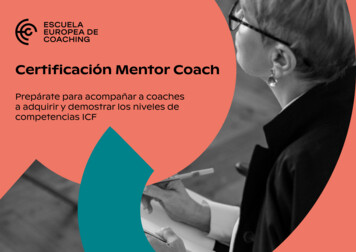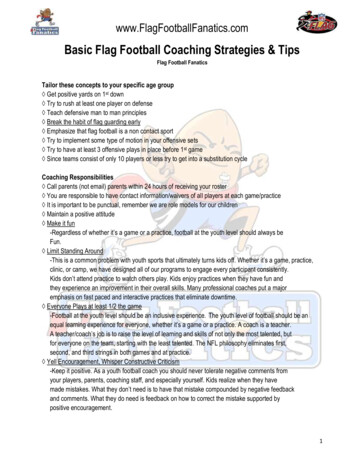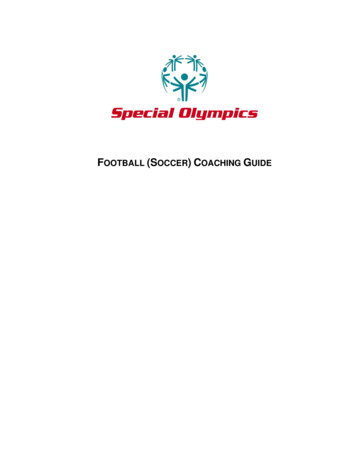
Transcription
FOOTBALL (SOCCER) COACHING GUIDE
Special Olympics Football Coaching GuideThe Benefits of FootballThe Benefits of FootballFootball is generally considered to be the world’s most popular team sport. Played in just about every country, thesport’s success is due to the fact that it can be played by boys, girls, men and women of just about any physical buildand ability. Football requires little in the way of specialized equipment and is organized using simple, intuitive rules.Football is a particularly appropriate sport for individuals with mental retardation. Football:Involves all of the participants constantly;Is easy to teach and immediately rewarding to play;Allows relatively rapid initial improvement in skills and basic game understanding;Is a great conditioning activity.Above all, football is fun.The wonderful thing about football is that you do not need to be an expert to begin coaching. You just needenthusiasm and a commitment to learn the basics. With some guidance, anyone with time and interest can become asuccessful Special Olympics football coach and help athletes with mental retardation join the worldwide footballfamily.A Preview of Football Events OfferedFootball competition is based upon athletes’ ability levels. Following is a summary of those competitionofferings.For athletes with lower ability, who do not have the readiness for direct, face-to-face offense and defense,competition is offered in individual skills competition.For athletes with average to moderate ability, competition is offered in modified team competition. The game isplayed in a smaller area and with a few modified rules. This game is simpler to understand and provides thetransition from individual skills to traditional team play.For athletes with higher ability, competition is offered in traditional 11-a-side team play and Special OlympicsUnified Sports football.For the actual football events offered, see the Official Special Olympics Sports Rules for Football.2Special Olympics Football Coaching GuideCreated: February 2004
Special Olympics Football Coaching GuideAcknowledgementsAcknowledgementsSpecial Olympics wishes to thank the professionals, volunteers, coaches and athletes who helped in the production ofthe Football Coaching Guide. They have helped fulfill the mission of Special Olympics: to provide year-round sportstraining and athletic competition in a variety of Olympic-type sports for people eight years of age and older withintellectual disabilities, giving them continuing opportunities to develop physical fitness, demonstrate courage,experience joy and participate in a sharing of gifts, skills and friendship with their families, other Special Olympicsathletes and the community.Special Olympics welcomes your ideas and comments for future revisions of this guide. We apologize if, for anyreason, an acknowledgement has been inadvertently omitted.Contributing AuthorsVenisha Bowler, Special Olympics, Inc.Floyd Croxton, Special Olympics, Inc., AthleteWanda S. Durden, Special Olympics, Inc.Mark Hanken, Special Olympics OregonDave Lenox, Special Olympics, Inc.Eddie Meechan, Special Olympics AustraliaPaul Rosin, Special Olympics ColoradoJon-Paul St. Germain, Special Olympics, Inc.Special Thanks To the Following for All of Your Help and SupportSpecial Olympics VirginiaStarring Athletes from Special Olympics VirginiaDavid SuttonDarryl McCainKara ConatySamantha ErricoVincent WoodhouseCharles SilfiesMelissa RoweEmily WiltDevin CameronRichie GregoryKatie BlindCorey Sullivan (Unified Sports Partner)Coaches from Special Olympics VirginiaCourtney BuffingtonJim BoydPhillip RedmanNicole DeCandiaSpecial Olympics Asia PacificSpecial Olympics Europe/EurasiaSpecial Olympics North AmericaSpecial Olympics Football Coaching GuideCreated: February 20043
FOOTBALL COACHING GUIDEPlanning a Football Training and Competition Season
Planning a Football Training and Competition SeasonTable of ContentsTable of ContentsGoals and ObjectivesSetting GoalsAssessing Goals ChecklistPlanning a Football Training and Competition SeasonSample Training PlanConfirmation of Practice ScheduleEssential Components of Planning a Football Training SessionConsiderations for PracticePreparing for PracticeSample Coaching GridPrinciples of Effective Training SessionsSample Practice Plan FormTips for Conducting Successful Training SessionsTips for Conducting Safe Training SessionsFootball Practice CompetitionsSelecting Team MembersAbility and Age GroupingCreating Meaningful Involvement in Unified SportsAthlete Skills AssessmentFootball Athlete Skills Assessment CardDaily Performance RecordFootball AttireFootball EquipmentSpecial Olympics Football Coaching GuideCreated: February 20045
Planning a Football Training and Competition SeasonGoals and ObjectivesGoalsRealistic, yet challenging goals for each athlete are important to the motivation of the athlete both at training and duringcompetition. Goals establish and drive the action of both training and competition plans. Sport confidence in athleteshelps to make participation fun and is critical to the athlete’s motivation. Please see the Principles of Coaching sectionfor additional information and exercises on goal setting.BenefitsIncreases athlete’s level of physical fitnessTeaches self-disciplineTeaches the athlete sports skills that are essential to a variety of other activitiesProvides the athlete with a means for self-expression and social interactionGoal SettingSetting goals is a joint effort between the athlete and coach. Following are the main features of goal setting.1.2.3.4.5.Structured into short-term, intermediate and long-termStepping stones to successMust be accepted by the athleteVary in difficulty – easily attainable to challengingMust be measurableLong-Term GoalThe athlete will acquire basic football skills, appropriate social behavior and functional knowledge of the rulesnecessary to participate successfully in football competitions.Assessing Goals Checklist1. Write a goal statement.2. Does the goal sufficiently meet the athlete’s needs?3. Is the goal positively stated? If not, rewrite it.4. Is the goal under the athlete’s control and does it focus on his/her goals and no one else’s?5. Is the goal a goal and not a result?6. Is the goal important enough to the athlete that he/she will want to work toward achieving it? Have the time andenergy to do it?7. How will this goal make the athlete’s life different?8. What barriers might the athlete encounter in working toward this goal?9. What does the athlete need to learn how to do?10. What risks does the athlete need to take?6Special Olympics Football Coaching GuideCreated: February 2004
Planning a Football Training and Competition SeasonSeason PlanningPlanning a Football Training and Competition SeasonThere will be many different skills to teach players during the course of a season. A season-long training plan will helpcoaches present skills in a systematic and effective way. The sessions in the plan below are organized in a twice-a-weekformat.Make time at each practice to work individually with your goalkeepers for 10-15 minutes. If you do not have anassistant coach, you may have to do this before or after the practice session.Sample Training PlanPreseasonWeek #1AssessmentFitnessAssessmentFitnessWeek #2DribblingFitnessDribblingRulesCompetition SeasonWeek #3ShootingRules/RestartsShootingRules/RestartsWeek #4ControlTeam Play/PositionsControlTeam Play/PositionsWeek #5PassingTeam Play/SupportPassingTeam Play/SupportWeek #6PassingTeam Play/WingsPassingTeam Play/SupportWeek #7Week #8Special Olympics Football Coaching GuideCreated: February 2004TacklingTeam Play/DefendingTacklingTeam Play/DefendingHeadingTournament PrepShootingTournament Prep7
Planning a Football Training and Competition SeasonSeason PlanningConfirmation of Practice ScheduleOnce your venue has been determined and assessed, you are now ready to confirm your training and competitionschedules. It is important to publish training and competition schedules to submit to the interested groups below. Thiscan help generate community awareness for your Special Olympics football program.Facility RepresentativesLocal Special Olympics ProgramVolunteer CoachesAthletesFamiliesMediaManagement Team MembersOfficialsThe training and competition schedule is not exclusive to the areas listed below.DatesStart and end timesRegistration and/or meeting areasContact phone number at the facilityCoaches phone numbers8Special Olympics Football Coaching GuideCreated: February 2004
Planning a Football Training and Competition SeasonPlanning a Training SessionEssential Components of Planning a Football Training SessionSpecial Olympics athletes respond well to a simple, well-structured training routine with which they can becomefamiliar. An organized plan, prepared before you get to the field, will help establish such a routine and help make bestuse of your limited time. A recommended training plan is outlined below.Warming Up/StretchingEvery player warms up with a ball; i.e., low-intensity dribbling drills.Stretch each muscle group.Have players lead the stretching while coaches assist individual players when necessary.Finish the warm-up with a fun dribbling/tag game.Skills InstructionQuickly review and practice previously taught skills.Introduce the theme of the skills activity.Demonstrate skills simply and dramatically.Divide into groups of six or less for practice.Physically assist and prompt lower ability players when necessary.Introduce and practice new skills early in the practice session.Competition ExperiencePlayers learn a lot by simply playing the game. The game is a great teacher.Use minigames (one vs. one / three vs. three) to teach basic rules and game understanding.Use scrimmages to teach basic positions and restarts.Always allow at least 10 minutes of free play where the coach says nothing. Let them play.Cool DownSlow run/walk/stretch.As the players cool down, comment on the session and the next game.Finish with a team cheer.Special Olympics Football Coaching GuideCreated: February 20049
Planning a Football Training and Competition SeasonPlanning a Training SessionConsiderations for PracticeWhen designing practices, exercises and drills, consider the strengths and weaknesses of each player and yourteam as a whole. Choose activities that allow your players to improve their weaknesses and exploit theirstrengths in competition.Teach so that your players learn to help coach each other. Instruct them to watch for correct and incorrecttechniques, movements and decisions when in pairs or groups. The feedback your players give each other willprove invaluable in developing team unity and help players develop a greater understanding of the game.Make practices fun. Design practices that hold players’ attention. Use exercises and drills that your playersenjoy. Use these exercises to lighten the load of hard work and to establish positive team attitude. Whenpracticing drills, do enough to improve technique, yet not so much as to bore your athletes.Keep your talking to a minimum. Short, concise instructions are better than long explanations.Be willing to create or adapt drills to meet unique needs of your team. Skilled players master drills fairlyquickly, so add some new twists to challenge these players.As you introduce new skills and techniques, you also need to review fundamental ones. Drills are a goodvehicle for addressing your players’ technical flaws.Introduce new skills early in the practice session, when players are fresh and attentive. Practice new skills forseveral days before incorporating them into more complex drills and game scenarios.And above all, be well organized.10Special Olympics Football Coaching GuideCreated: February 2004
Planning a Football Training and Competition SeasonPlanning a Training SessionPreparing for PracticeYour Practice PlanPractice is where you teach, make mistakes, gain fitness, practice game strategy and tactics and prepare for the nextcontest. A successful practice plan creates an environment that helps you accomplish your goals. With your goals inmind, design your practices specifically to fulfill those goals. Be sure to determine the time needed for each phase ofpractice. However, be willing to make time adjustments, depending on specific circumstances.You need to develop a season plan just as you develop your individual practice sessions. Take time to reviewweekly, tournament and league-play goals and objectives for your team. Write out these goals before the start of theseason. Each practice session is one block of a performance block. The better each block fits with the others, thestronger and higher the blocks will grow.Equipment SetupBefore each day’s practice begins, determine the sequence of drills and where you will set up equipment. Whenpossible, set up your practice field and equipment before the start of practice. Setting up and moving equipment canwaste valuable practice time. Set up equipment early and assign different groups to bring out balls, cones, nets, goalsand other equipment. You can also designate exercise captains to help organize players for drills, creating leaderswithin the team.Coaching GridsGrids are a great way to organize players and make maximal use of your practice field. They let you organize the fieldinto distinct areas the size of which can be adapted to fit the skill level and number of the players involved. You cancreate grids by using cones, flags or other markers.The game of football is about time and space. The best players can control the ball in little time and within a smallspace. Less skilled players need more time and greater space in which to perform. Coaching grids let you adjust thefield of play according to the technical abilities of your athletes.You can use the attached coaching grid to develop your own plays and game strategy.Special Olympics Football Coaching GuideCreated: February 200411
Planning a Football Training and Competition SeasonPlanning a Training SessionSample Coaching Grid12Special Olympics Football Coaching GuideCreated: February 2004
Planning a Football Training and Competition SeasonPlanning a Training SessionPrinciples of Effective Training SessionsKeep all activeAthlete needs to be an active listener.Create clear, concise goalsLearning improves when athletes know what is expected of them.Give clear, concise instructionsDemonstrate – increase accuracy of instruction.Record progressYou and your athletes chart progress together.Give positive feedbackEmphasize and reward things the athlete is doing well.Provide varietyVary exercises – prevent boredom.Encourage enjoymentTraining and competition is fun; help keep it this way for you and yourathletes.Create progressionsLearning is increased when information progresses from:Known to unknown – discovering new things successfullySimple to complex – seeing that “I” can do itGeneral to specific – this is why “I” am working so hardPlan maximum use of resourcesUse what you have, and improvise for equipment that you do not have –think creatively.Allow for individual differencesDifferent athletes, different learning rates, different capacities.Special Olympics Football Coaching GuideCreated: February 200413
Planning a Football Training and Competition SeasonPlanning a Training SessionSample Practice Plan FormDate:Location:Time:Goals:Warm Up - Make the body ready for practice.LeaderActivityEquipmentTeam Talk - Let the athletes know your expectations for practice.Goals for TodayPrevious SkillLessonNew Skill LessonSkill Development - Games and exercises to reinforce learning. Make it fun.LeaderActivityEquipmentBreak - Supply water and take the skill into the scrimmage.Reinforce Skillfrom Today:Scrimmage - Emphasize last week’s skill and new skill.Previous SkillNew SkillTeam Talk - Emphasize new skill and techniques from scrimmage.ScrimmageLesson 1ScrimmageLesson 2Review LastWeek’s SkillReviewHomeworkDeveloped by The Coaching Corner TM - www.thecoachingcorner.com14Special Olympics Football Coaching GuideCreated: February 2004
Planning a Football Training and Competition SeasonPlanning a Training SessionTips for Conducting Successful Training SessionsAssign assistant coaches their roles and responsibilities in accordance to your training plan.When possible, have all equipment and stations prepared before the athletes arrive.Introduce and acknowledge coaches and athletes.Review intended program with everyone. Keep athletes informed of changes in schedule or activities.Alter the plan according to weather, and the facility, to accommodate the needs of the athletes.Change activities before the athletes become bored and lose interest.Keep drills and activities brief so athletes do not get bored. Keep everyone busy with an exercise, even if it isrest.Devote the end of the practice to a fun, group activity that can incorporate challenge and fun, always givingthem something to look forward to at the end of practice.If an activity is going well, it is often useful to stop the activity while interest is high.Summarize the session and announce arrangements for next session.Keep the “fun” in fundamentals.Special Olympics Football Coaching GuideCreated: February 200415
Planning a Football Training and Competition SeasonPlanning a Training SessionTips for Conducting Safe Training SessionsThough the risks can be few, coaches have a responsibility to ensure that athletes know, understand and appreciate therisks of football. The safety and well-being of athletes are the coaches’ primary concerns. Football is not a dangeroussport, but accidents do occur when coaches forget to take safety precautions. It is the head coach’s responsibility tominimize the occurrence of injuries by providing safe 16Establish clear rules for behavior at your first practice and enforce them.Keep your hands to yourself.Listen to the coach.When you hear the whistle, “stop, look, and listen.”Ask the coach before you leave the field of play.When the weather is poor, have a plan to immediately remove athletes from inclement weather.Make sure athletes bring water to every practice, especially in hotter climates.Check your first-aid kit; restock supplies as necessary.Train all athletes and coaches on emergency procedures.Choose a safe field area. Do not practice in areas with rocks or holes that could cause injury. Simply tellingplayers to avoid obstacles is not enough.Walk the field and boundary and remove unsafe objects. Be particularly vigilant when you are playing incluttered indoor gyms. Remove anything that a player might run in to.Check the balls for loose panels that could cause eye injury.Check the goals for poorly secured posts and cross-bars. Instruct players never to swing on goals. Payparticular attention to portable goals that could tip over in a high wind or if players swing on the cross-bar.Make sure these goals are securely staked into the ground.Review your first-aid and emergency procedures. Have someone who is trained in first aid andcardiopulmonary resuscitation on or very near to the field during practice and games.Establish clear rules for behavior at your first practice.Warm up and stretch properly at the beginning of each practice to prevent muscle injuries.Train to improve the general fitness level of your players. Physically fit players are less likely to get injured.Make your practices active.Make sure that players are physically matched in games where players go against each other, head-to-head,(e.g., one-on-one drills).Require all your players to wear shin pads at practices and games. The use of athletic cups and fitted mouthguards is recommended, particularly for players with slower reactions.Do not put a player with a very slow reaction time in goal. Make sure that a goalkeeper is able to understandhow to play the position safely.Special Olympics Football Coaching GuideCreated: February 2004
Planning a Football Training and Competition SeasonPlanning a Training SessionFootball Practice CompetitionsThe more we compete, the better we get. Part of the strategic plan for Special Olympics football is to drive more sportdevelopment at the local levels. Competition motivates athletes, coaches and the entire sport management team. Expandor add to your schedule as many competition opportunities as possible. We have provided a few suggestions below.1.2.3.4.5.6.Host football games with adjacent local Programs.Ask the local high school team if your athletes can compete with them in practice football games.Join the local community football league, club and/or associations.Create your own football league or club in your community.Host weekly football games for the area.Incorporate competition components, scrimmages at the end of every training session.Simulate Game SituationsFootball requires accurate and quick decision making. The ability to recognize situations, understand the pitch andmake appropriate decisions is very important. Recognition skills are best learned in game settings. Create practicesituations that emphasize skill and tactics likely to be encountered during a game. Practicing in a game-like setting willhelp your players learn to recognize when certain skills or tactics are appropriate. For example, playing four vs. four ona small field with regular goals is a great way to emphasize player movement and shooting, rather than simply shootingat the goal without opposition or movement.Please refer to the Teaching Football Skills section to incorporate different types of teammate scrimmages intopractice sessions. Scrimmages at practice allow players to develop a feel for the game, field positioning and basictechnique in game-like situations.Keep AwayObjective: One team attempts to keep possession of ball for as long as possible.Steps1.2.3.4.5.Mark a designated area of the pitch.Create teams of unequal numbers with the larger teams having initial control of the balls.One team will have one or more balls.Player with ball moves only in marked area.Player with ball may have unlimited contacts with ball for no longer than three seconds.Ball to the GoalieObjective: Each team attempts to get possession of ball and pass it to its own goalie located at the opposite end of thecourt, standing behind specified line.Steps1. Create two teams of equal numbers; one team has the ball.2. Goalie stands inside a marked space (e.g., circle) and may not step outside to catch the ball.3. Team with the ball must pass to at least two or more teammates before attempting to pass the ball to theirgoalie.4. Defenders must keep a four-foot distance from the goalie’s designated area.5. Start game with two to three players per team with one ball and gradually add players.6. Add balls and goalies, maintaining a 1-1 ratio between number of goalies and number of balls.Special Olympics Football Coaching GuideCreated: February 200417
Planning a Football Training and Competition SeasonSelecting Team MembersSelecting Team MembersThe key to the successful development of a traditional Special Olympics or Unified Sports team is the proper selectionof team members. We have provided some primary considerations below.Ability GroupingUnified Sports football teams work best when all team members have similar sports skills. Partners with abilities thatare far superior to other teammates will either control competition or accommodate others by not competing to theirpotential. In both situations, the goals of interaction and teamwork are diminished and a true competitive experience isnot achieved.Age GroupingAll team members should be closely matched in age.Within 3-5 years of age for athletes 21 years of age and under.Within 10-15 years for athletes 22 years of age and over.For example, in football, an 8-year-old should not be competing against or with a 30-year-old athlete.Creating Meaningful Involvement in Unified SportsUnified Sports embraces the philosophy and principles of Special Olympics. When selecting your Unified Sports teamyou want to achieve meaningful involvement at the beginning, during and end of your sport season. Unified Sportsteams are organized to provide meaningful involvement for all athletes and partners. Every teammate should play a roleand have the opportunity to contribute to the team. Meaningful involvement also refers to the quality of interaction andcompetition within a Unified Sports team. Achieving meaningful involvement by all teammates on the team ensures apositive and rewarding experience for everyone.Indicators of Meaningful InvolvementTeammates compete without causing undue risk of injury to themselves or others.Teammates compete according to the rules of competition.Teammates have the ability and opportunity to contribute to the performance of the team.Teammates understand how to blend their skills with those of other athletes, resulting in improvedperformance by athletes with lesser ability.Meaningful Involvement Is Not Achieved When Team MembersHave superior sports skills in comparison to their fellow team members.Act as on-field coaches rather than teammates.Control most aspects of the competition during critical periods of the game.Do not train or practice regularly and only show up on the day of competition.Lower their level of ability dramatically, so that they do not hurt others or control the entire game.18Special Olympics Football Coaching GuideCreated: February 2004
Planning a Football Training and Competition SeasonFootball AttireFootball Athlete Skills AssessmentThe sport skills assessment chart is a systematic method that is useful in determining the skill ability of an athlete. TheFootball Skills Assessment Card is designed to assist coaches in determining athletes’ ability levels before they beginparticipation. Coaches will find this assessment a useful tool for several reasons.1.2.3.4.5.Help coach to determine with the athlete which events they will compete in.Establish the baseline training areas of athlete.Assist coaches to group athletes of similar ability on training teams.Measure the athlete’s progression.Help determine athlete’s daily training schedule.Before administering the assessment, coaches need to perform the following analysis when observing the athlete.Become familiar with each of the tasks listed under the major skills.Have an accurate visual picture of each task.Have observed a skilled performer executing the skill.When administering the assessment, coaches will have a better opportunity in getting the best analysis from theirathletes. Always begin by explaining the skill you would like to observe. When possible, demonstrate the skill.Special Olympics Football Coaching GuideCreated: February 200419
Planning a Football Training and Competition SeasonDaily Performance RecordSpecial Olympics Football Skills Assessment CardAthlete’s NameDateCoach’s NameDateInstructions1.2.3.4.5.Use tool at the beginning of the training/competition season to establish a basis of the athlete’s starting skilllevel.Have the athlete perform the skill several times.If the athlete performs the skill correctly three out of five times, check the box next to the skill to indicate thatthe skill has been accomplished.Program assessment sessions into your program.Athletes may accomplish skills in any order. Athletes have accomplished this list when all possible items havebeen achieved.Control-ReceivingControls ball using inside of footControls ball using chestControls ball using thighCushions ball with chest or thighDistributes body weight, so that they are able to move backward, forward or sidewaysJudges ball flight speed appropriatelyChooses the right technique and body surface to control ballDribblingDribbles forward, using the top of footUses inside of foot to quickly change directionUses outside of foot to shield ball from opponentsUses sole of foot to change ball directionDribbles up field with ball while walkingDribbles up field with ball while runningPassingSquares up ball, player and target in a straight lineMakes eye contact with intended receiverFollows through in direction of intended receiver kicking footPlaces kicking foot flat against back of ballContacts ball with the toes pulled up, foot parallel to ground and ankle locked20Special Olympics Football Coaching GuideCreated: February 2004
Planning a Football Training and Competition SeasonFootball AttireShootingApproaches ball from sidePlaces nonkicking foot by side of ballControls ball before shootingTacklingLeans upper body into front-block tackleMaintains good balance with outstretched leg in side-block tackleTracks and closes down on opponents dribbling the ballKnows when to use appropriate tackle techniqueMoves quickly to close distance to opponent with ballFocuses attention on ball, not opponent’s bodyHeadingAttempts to head the ballLooks at ball as it comes toward the headRocks onto back foot before ball arrivesAttacks through ball for powerDirects ball in correct, general directionDirects ball with accuracyHeads ball while standingHeads ball while jumpingGoalkeepingMaintains concentration when ball is away from the goalGets behind the line of the ballScoops low balls up with legs straight and togetherGoes down on one knee and scoops up low ballsSecures high ball with both hands working together as one unitDives on side of bodyDistributes the ball using appropriate techniqueSpecial Olympics Football Coaching GuideCreated: February 200421
Planning a Football Training and Competition SeasonDaily Performance RecordDaily Performance RecordThe Daily Performance Record is designed to keep an accurate record of the athlete’s daily performance as they learn asports skill. There are several reasons why the coach can benefit from using the Daily Performance Record.1.2.3.4.The record becomes a permanent document of the athlete’s progress.The record helps the coach establish measurable consistency in the athlete’s training p
The wonderful thing about football is that you do not need to be an expert to begin coaching. You just need enthusiasm and a commitment to learn the basics. With some guidance, anyone with time and interest can become a successful Special Olympics football coach and help athletes with mental retardation join the worldwide football family.
